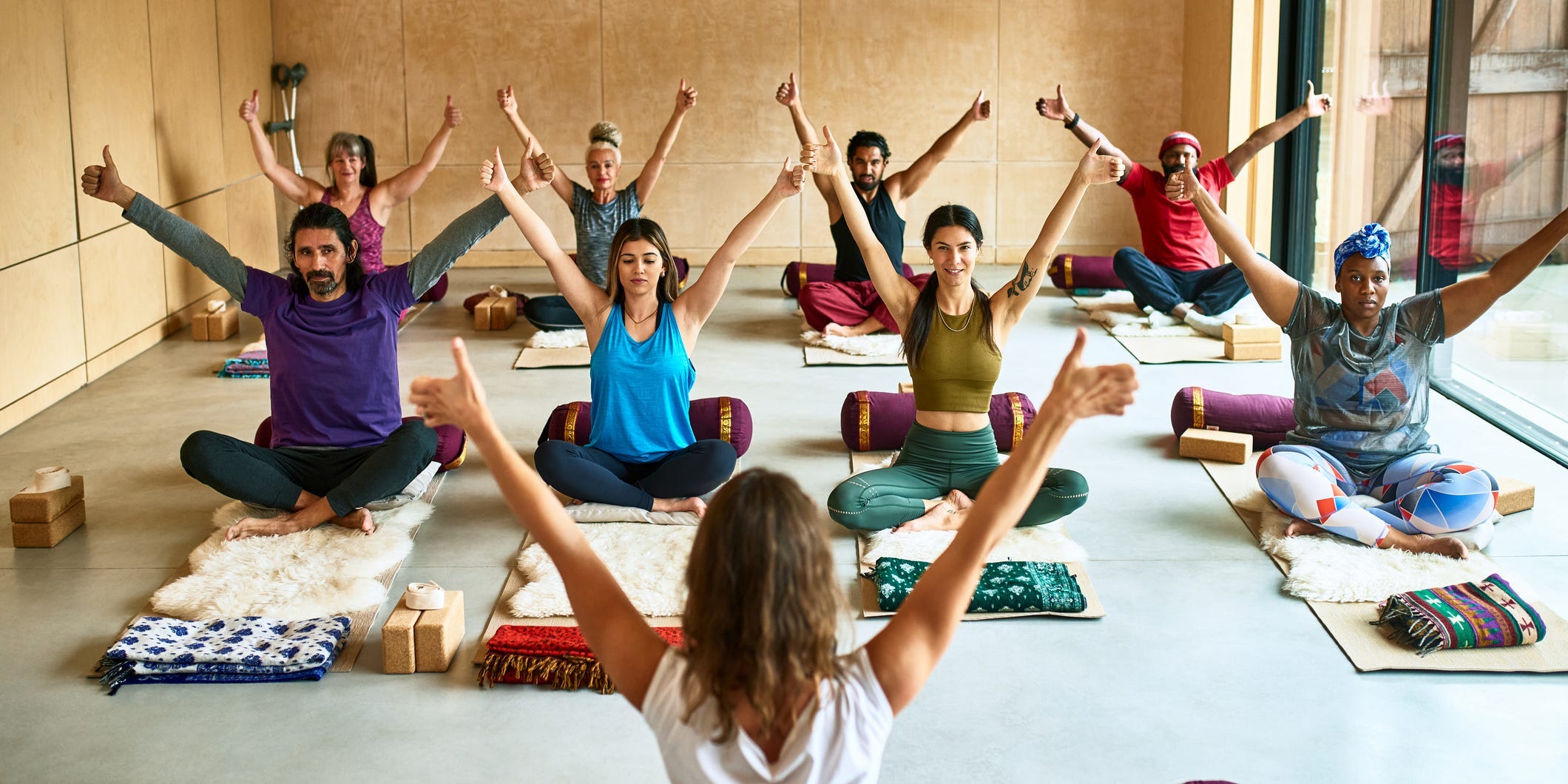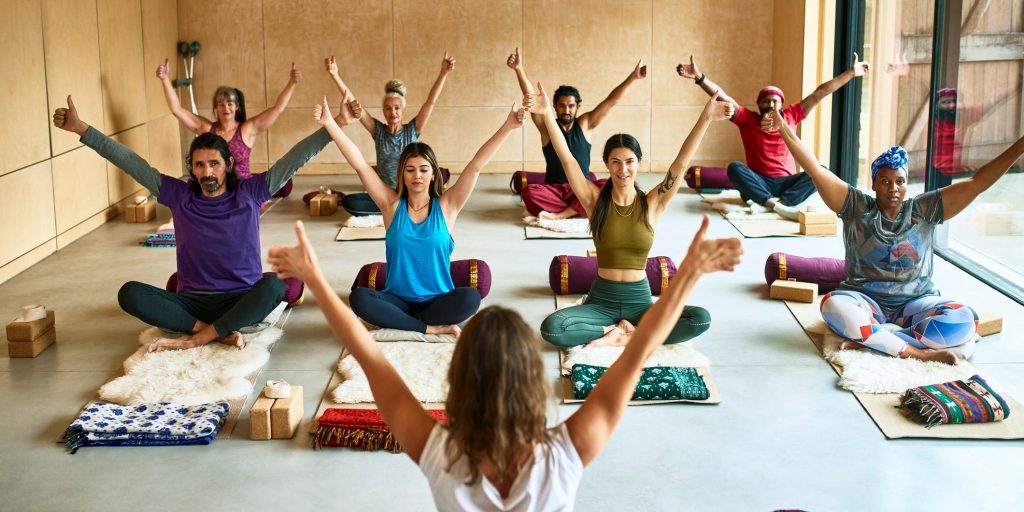
10'000 Hours/Getty Images
- Types of yoga include hatha, Iyengar, vinyasa, hot yoga, and ashtanga.
- For an aerobic workout, a vinyasa class might be the best to boost your heart rate.
- If you're looking for a more meditative class, ashtanga focuses on mindful movement.
- Visit Insider's Health Reference library for more advice.
Yoga is a South Asian spiritual practice involving body movement, breathing exercises, and meditation. In the US, most yoga classes focus on the asana, or body movement, aspect of yoga.
There are many styles of yoga, like vinyasa and ashtanga, that have evolved over time, each with its own benefits for your body and mind.
Here are five types of yoga you can try, depending on whether you want to increase your flexibility or reduce anxiety.
1. Vinyasa
Vinyasa yoga classes include many of the classic yoga poses, like those in the sun salutation sequence. But instead of holding still in poses, you 'flow,' between poses in continuous movement, says Arundhati Baitmangalkar, lead teacher and founder of the Aham Yoga studio.
Moving fluidly from one pose to another helps you sync up your breath with your movement – creating a calming effect, says Baitmangalkar.
In fact, "many people find this style of yoga to be a kind of moving meditation," says Jesal Parikh, yoga teacher and founder of Yogawalla.
This kind of calming practice may be helpful for people with conditions like anxiety and depression. In a small 2010 study, people with depression had significantly decreased symptoms after doing vinyasa yoga twice per week for two months.
Vinyasa yoga may also be a good option if you're looking to build up your endurance. It's "often taught in a strong and athletic way, creating a sweat-inducing, cardiovascular effect," says Parikh.
Studies show that vinyasa yoga works well as aerobic exercise - meaning it boosts your heart and breathing rate. Getting this type of exercise is important for your heart and lung health and can help prevent diseases like diabetes and heart disease.
2. Ashtanga
Ashtanga yoga shares some elements with vinyasa yoga, including the flowing movement and breathing style.
But while vinyasa classes are more varied, ashtanga has a set sequence of poses that you can't deviate from, Baitmangalkar says.
Ashtanga yoga classes also tend to place a greater emphasis on meditation, Parikh says, which means it can have additional benefits for your mental health.
For example, a small 2017 study found that people who did ashtanga yoga twice per week for nine weeks had significant improvements in their self-esteem, and decreased symptoms of depression and anxiety.
3. Hatha
Traditionally, hatha yoga is an umbrella term that encompasses many different styles of yoga.
"Most styles of yoga we know today are considered Hatha yoga," Parikh says. This includes vinyasa, hot yoga, ashtanga, and iyengar styles.
But in the western world, a hatha yoga class generally means that you will be holding poses for longer periods of time, compared with a style like vinyasa, Baitmangalkar says.
For example, in vinyasa practice, you might hold a pose for only a few seconds, while Hatha poses can last for over a minute.
Hatha yoga poses may be performed while standing, sitting, or lying down. And because you're holding them for longer periods, it can help you build strength and improve balance.
A 2016 study found that people who did Hatha yoga had significant improvements in their balance and core strength after 21 days of training.
4. Iyengar
Iyengar yoga is another slow style of yoga, where you hold poses for longer periods, but it also includes physical props like yoga blocks and straps.
"Iyengar yoga is a system of yoga where the emphasis is on precise alignment of the body," Baitmangalkar says.
Iyengar can be a great option if you don't have full mobility in your body because yoga props can help you get into proper alignment. "The Iyengar style of yoga was one of the first to accommodate physical limitations," Parikh says.
Studies show that regularly practicing Iyengar yoga may help relieve symptoms of conditions like chronic lower back pain and osteoarthritis of the knees.
5. Hot yoga
Hot yoga is another yoga style with a more rigid sequence. In hot yoga classes, you will generally do two sets involving a series of 26 poses in 104 °F heat, Parikh says.
Hot yoga is sometimes called Bikram yoga, but many studios have moved away from using this name after criminal allegations have been raised about Bikram Choudhury, the founder of the practice.
While the heat can be intimidating, hot yoga devotees feel that it can offer a mood boost. "Those who practice this style of yoga often feel the positive effects of the increased sweating of this practice, sometimes described as 'euphoric,'" says Parikh.
The hot temperature may also help to loosen muscles and improve flexibility. In a small 2013 study, people who did hot yoga three times per week for two months had significant improvements in the flexibility of their hamstrings, lower back, and shoulders.
Insider's takeaway
There are many different styles of yoga that can each have powerful emotional and physical benefits.
A vinyasa class may be the best option to get your heart pounding, while iyengar may be best if you struggle with chronic pain.
If you aren't sure if yoga is right for you, talk to your doctor about the best exercise options for your body.
